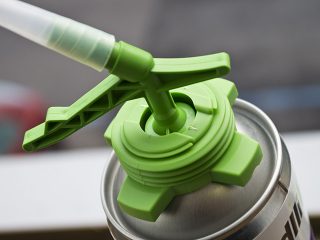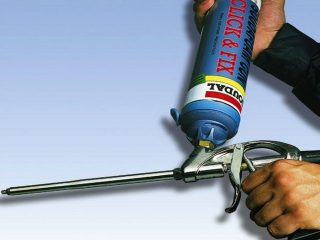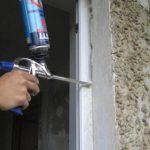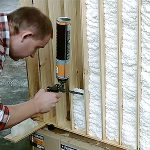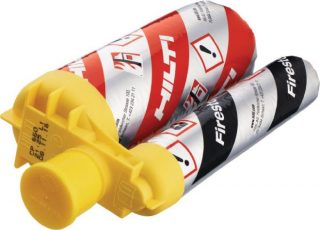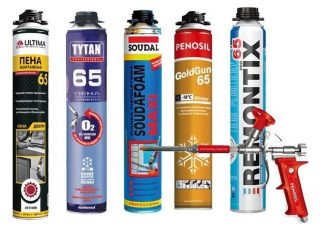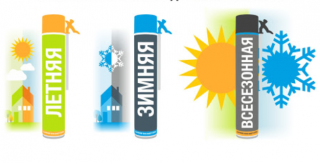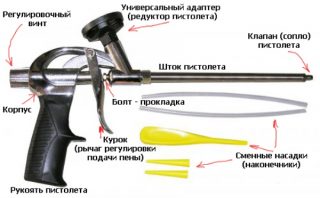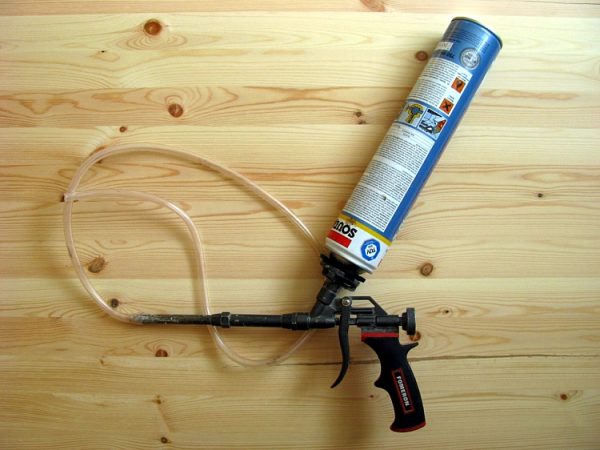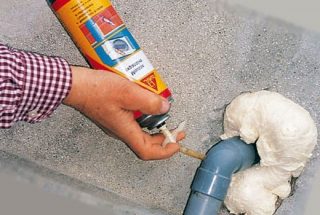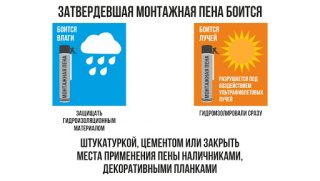In construction and repair work, sealants are widely used. Their task is to prevent the passage of moisture and air through cracks, joints, seams. Polyurethane foam is one of the options for such a tool. It waterproofs the joints and fills them.
Description and release form of polyurethane foam
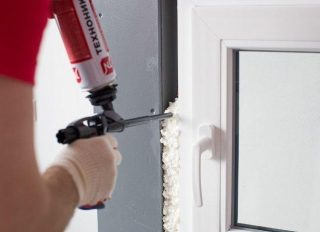
Polyurethane foam is a polyurethane foam sealant. However, it becomes such only at the moment of combination of 2 main components - methylene diphenyldiisocyanate and polyols. Prepolymer located inside the cylinder. It is not yet polyurethane foam.
The second physical component of the product is propellant, that is, a mixture of gases, partly liquefied, partly gaseous, partly dissolved in the original mixture. The propellant has a much lower boiling point and is in the container under high pressure, much higher than atmospheric pressure.
When leaving the cylinder, this gas-liquid mixture boils, displaces the prepolymer and saturates the mass of the resulting polyurethane foam with bubbles... The volume of the obtained foam is large, equal to the total total volume of the prepolymer and propellant in the gaseous state. Since the mixture is also saturated with surfactants - silicones - as a rule, air bubbles do not break out of the mass and remain when the polyurethane foam hardens. Some of the bubbles reach the surface and form open pores.
Boiling is only the first stage of the process. When the mass comes out and in contact with air and moisture from the air, the polymerization process is completed. Wherein carbon dioxide is emitted... The mass increases slightly in volume and fills the joints and cracks. As the polymerization is completed, the foam solidifies, forming a porous, lightweight, but strong structure that is impermeable to cold air and water.
Release polyurethane foam only in cylinders... There are the following types:
- with a plastic trigger attachment - a household option;
- with a valve for a pistol - a pistol nozzle should be attached to the container, which allows you to adjust the speed of the mass outlet.
The first option can be used several times, it is enough to blow through the tube. The model with a gun is used continuously until the mixture ends, or after the end of the work it is disassembled and washed.
Scope of application
- joint sealing after installing windows and doors;
- sealing joints when cladding walls, laying a substrate, finishing a ceiling;
- filling and waterproofing joints and resulting cracks in the wall and roof material;
- as a heater when constructing external structures such as air vents, outlets for antennas and accessories;
- for sealing joints of plumbing fixtures, pipelines;
- in roofing works of any kind.

Classification
A wide variety of additives are added to the initial mixture during manufacture.Modifiers impart greater strength and elasticity to the product, increase or decrease the drying rate, and affect the coefficient of expansion and shrinkage.
By composition distinguish between one- and two-component polyurethane foam.
- One-component - the ingredients of the prepolymer are mixed in advance and in finished form are pumped into the balloon. This technology is rarely used, since one-component polyurethane foam has an extremely limited shelf life. It is stored for no more than 1 year, after which the balloon can be thrown away: its contents irrevocably harden.
- Two-component - the original ingredients in the bottle do not mix with each other. Before use, the shutter is turned at the bottom of the cylinder, which opens the chamber and allows the components to mix. Shake the container before use to allow the ingredients to combine and start working. Before the first use, the balloon can be stored for years. In addition, such a mixture does not freeze instantly, but after 20-30 minutes, that is, it provides time for adjustment.
The volume of two-part foam is less than one-part foam. This must be taken into account when calculating.
- Summer - effective at temperatures from +4 to + 36 ° C, when the air contains a sufficiently large amount of moisture.
- Winter - designed for use in frosts down to -12 and even -16 ° C. Before using it in the cold, it is recommended to lower the cylinder into a basin with hot water and warm it up.
- All-season - action from -10 to + 40 ° С. It is a versatile option for any dry weather.

Rules for working with a pistol
- From a balloon remove the cap and place the pistol with the handle down.
- Install capacity vertically with the adapter down. The cylinder is screwed in clockwise, holding the pistol grip.
- Capacity good shake upso that the prepolymer inside mixes and a chemical reaction occurs. Shake up at least 15 times.
- Then overturn the pistol with the handle up, and with the cylinder down and turn the screw a quarter of a turn. Then pull the triggerfilling the tube of the pistol. If the pressure is insufficient, turn the adjusting screw until the desired pressure is obtained. Then they get to work.
- For filling vertical joints foam is served from below, moving up. If the gap is wide, the nozzle is slightly turned left and right, feeding the foam in a zigzag manner.
- Mixing adjust by screw... If a wide cavity is filled, the pressure is increased; if a narrow one, it is decreased.
- The seams are filled no more than 1/3. The material expands and fills in the remaining space. It is easier to add a little foam if it is not enough than to remove the excess later.
For the treatment of hard-to-reach areas, an additional nozzle is used - extension tube.
Before foaming, the area is moistened with water, since polyurethane foam needs moisture for normal expansion and hardening.
How to rinse
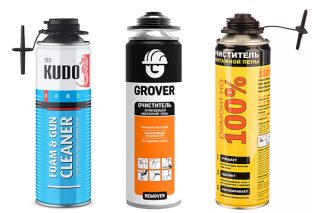
The procedure is performed after completion of work without fail. If the gun is used continuously, it is flushed every 5-6 days. Apply for this special flushing agent.
- The gun is turned away from themselves and the can is unscrewed.
- Fix the container with the flushing agent.
- Pull the trigger as if to dispense foam. In this case, the tube is filled with a cleaning agent.
- The gun is left for 20 minutes so that the product dissolves all foam residues.
- Pull the trigger and remove the cleaning solution. Flush the gun again with clean fluid to ensure no foam remains. Remove the spray can.
- Close the adjusting screw and store the gun.
If the foam hardens inside the nozzle, it will be much more difficult to get rid of it. Polyurethane foam is practically insoluble.
How to use foam without a gun
- The container is shaken for 30 s, the cap is removed and the tube is installed. It is usually included in the package, but you can buy it separately.
- The end of the tube is brought to the area to be treated, the trigger is pulled and the foam is squeezed into the slot. It is filled by no more than 30–35%. Foam can be added if necessary.
- The tube is short, there is no need to hold it with your hand. However, filling the seam will take time.
Polyurethane foam with a tube is a rather expensive option. At the same time, the consumption of material is higher, since it is difficult to manually adjust the feed rate. It will also take more time, since it is more difficult to control the volume of the supplied mass.
Helpful hints
- The shelf life after opening depends on the composition of the mixture. One-component, after shaking, should be used whole at a time. The two-component can be stored and applied for up to a month.
- Is it possible use the same balloon several times, also depends on the composition of the mixture and the device of the container. It is best to use it immediately at a time, since the vessel itself is a disposable container. At the exit, the prepolymer, in contact with moisture and air, begins to harden, so the feed tube quickly becomes clogged. Repeatedly, more precisely with a break, a cylinder with a supply valve can be used.
- During work allowed breaks no more than 30 minutes.
Expired foam cannot be used. During storage, the original mixture thickens and then hardens. The process is slow for six months, and by the end of the storage period it is sharply accelerated. Cured polyurethane must not be used.

